Don't Be Fooled This April by Pretty Flowers: Lesser Celandine is a Springtime Menace
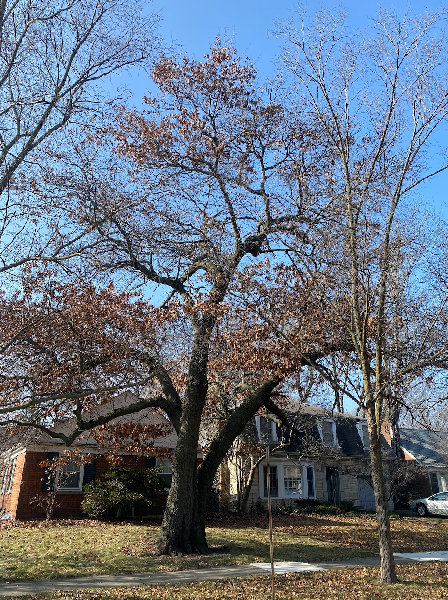
Earth Day by Jane Yolen
I am the Earth
And the Earth is me.
Each blade of grass,
Each honey tree,
Each bit of mud,
And stick and stone
Is blood and muscle
Skin and bone.
And just as I
Need every bit
Of me to make
My body fit,
So Earth needs
Grass and stone and tree
And things that grow here
Naturally.
That’s why we
Celebrate this day.
That’s why across
The world we say:
As long as life,
As dear, as free
I am the Earth
And the Earth is me.
Learn about marcescent trees in the fun fact section below.
Every spring arrives and I feel a sort of dread... I visit the property of another new client who wants to do more to create a healthy ecological system in their yard only to encounter…lesser celandine! I seek guidance for the best possible solution to the problem but the answers don’t always come quickly. But I know we need to do something and together with my clients and agencies like Midwest Grows Green. We are all in a process of experimenting with different controls and working toward protecting the rich diversity of this region by addressing this one yard at a time.
Julia Bunn, Spirited Gardener
Remove it ASAP
Lesser celandine is or will be blooming shortly in the area. If this plant is on your property, you should take steps to remove it. Eradication is difficult but important – the problem only gets worse, and quickly. This plant blooms in early spring and quickly takes over areas before native plants have the time to establish themselves.
Articles have been appearing about the problem of this plant in Illinois as early as 2005 when it had already been placed on the invasive species list for Wisconsin! As individual landowners we all have the agency to make a difference. The Spirited Gardener Team participated in a Midwest Grows Green event recently to work toward the goal of eradicating this plant from our area.
Ways to treat it:
1. Dig it out at depth to get all the tubers.
2. Do not allow it to seed if you have a large amount and you're trying to control it.
There are other solutions that continue to be researched:
- Smother the area with cardboard, and mulch over it to reduce the amount of sunlight the plants can receive to grow flowers and produce more seed.
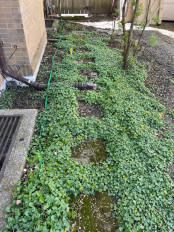
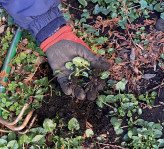
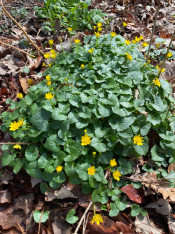
The local Village of Riverwoods has stated this fact clearly and succinctly on their website:
"As Robert Sullivan, a Horticulturist at the Center on Halsted, says: Lesser celandine is an attractive but highly invasive plant that is seriously damaging to native ecosystems in northern Illinois. It is an exotic spring ephemeral and a vigorous growing groundcover that forms large, dense patches on the forest floor, displacing and preventing native plants from co-occurring. The ecological impact of lesser celandine is primarily on the native spring- flowering plant community and the various wildlife species associated with them."
There are native plants that are resilient to invasive plants like lesser celandine. Plant these natives to claim back our native ecology:
- Common Violets
- Sedges short and tall
- Wild Columbine in part sun
- Jacob’s Ladder
- Big Leaf Aster
- Golden Ragwort - for areas you don’t mind if there is a spread of the plant
- American Bellflower
- Wild Blue Indigo
- Amsonias
_____________________________________________________
EcoFun Fact: Marcescent Trees
Forests in temperate regions are known for their beautiful leaf drop in autumn, but some trees keep their dead leaves all winter – a phenomenon called marcescence. This trait is common in trees like American beech and oak. Despite being noticed centuries ago, the reasons and impacts of marcescence are not fully understood.Heberling & Muzika (2023) explored why leaf marcescence occurs in temperate forests in their new research paper. They found that marcescence is much more common in smaller trees and the lower branches of larger trees. Marcescent leaves stay on the branches all winter and tend to fall in a short period in early spring.
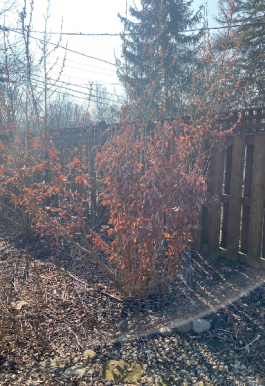 To the left: Witch Hazel is marcescent
To the left: Witch Hazel is marcescentPossible reasons this could happen include (2023):
- No reason: Marcescence may simply be a leftover evolutionary trait without a current benefit.
- Deters Herbivores: Dead, dry leaves may protect buds and twigs from being eaten by deer and insects in winter.
- Nutrient Efficiency: Keeping leaves longer might increase nutrient resorption or allow for late-season photosynthesis.
- Litter Benefits: Marcescent leaves falling in spring might lead to better decomposition timing and nutrient availability for the tree.
- Bud Protection: Marcescent leaves could shield overwintering buds from freezing or drying out.
- Animal Habitat: The leaves may provide winter shelter for beneficial animals like birds and bats, improving soil nutrients via their droppings (and perhaps even protect the homes of certain insects over-wintering in the dead leaves because they aren't blown away by landscapers) *.
*Nature continues to amaze!! This is my favorite one.
References:
Heberling, J. Mason, and Rose-Marie Muzika. 2023. “ Not All Temperate Deciduous Trees are Leafless in Winter: The Curious Case of Marcescence.” Ecosphere 14(3): e4410. https://doi.org/10.1002/ecs2.4410




